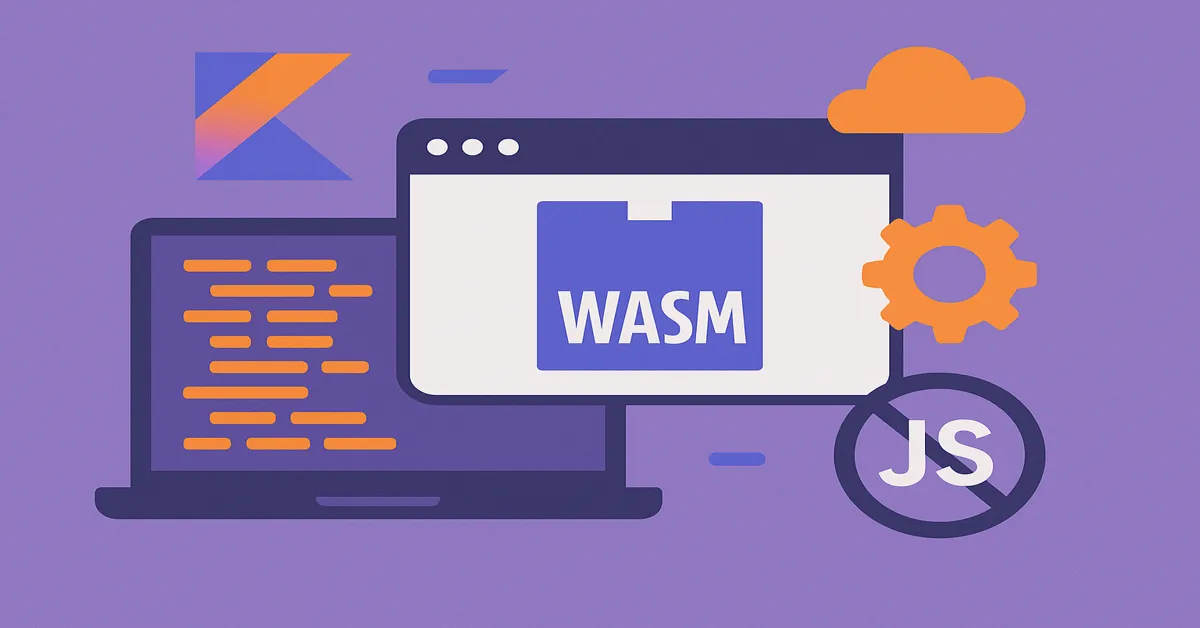In the evolving landscape of software development, where performance, security, and maintainability are paramount, a quiet but profound shift is taking place. Kotlin—once synonymous with Android development—is now knocking on the door of the web’s most sacred territory: the frontend. With Kotlin Wasm (WebAssembly), developers can now write robust, modern web applications in pure Kotlin, eliminating their dependence on JavaScript for client-side development.
This is more than a novelty. It signals a potential sea change in how developers think about programming for the browser.
The Rise of WebAssembly and the Kotlin Answer
WebAssembly (Wasm) is a binary instruction format designed as a portable compilation target for high-level languages like C, Rust, and now Kotlin. It’s fast, secure, and designed to run alongside—or in place of—JavaScript in web browsers.
Kotlin Wa-sm is JetBrains’ official response to the growing demand for multi-platform development. With Kotlin’s growing presence on the server, desktop (via Compose Multiplatform), mobile (KMM), and now web (via Wasm), the language is stepping confidently into full-stack territory.
Why WebAssembly?
At its core, WebAssembly was built for:
- Speed: It executes at near-native speed using a compact binary format.
- Portability: It runs across all major browsers without plugins.
- Security: It’s sandboxed and safe by design.
- Language Flexibility: It supports compilation from many languages—not just JavaScript.
Kotlin’s Wasm target builds on these pillars while offering a language that developers already know and love.
Kotlin/JS vs Kotlin Wasm: A Paradigm Shift
Until recently, Kotlin’s primary answer for frontend development was Kotlin/JS, which transpiles Kotlin code into JavaScript. While Kotlin/JS serves many use cases—especially when targeting existing JavaScript APIs—it comes with several challenges:
- Performance limitations due to the JavaScript runtime.
- Large bundle sizes from transpilation.
- Debugging complexity in deeply transpiled code.
Kotlin Wa-sm eliminates these limitations by compiling directly to WebAssembly, skipping JavaScript altogether. The result is:
- Smaller, leaner web bundles.
- Dramatic performance improvements.
- Cleaner separation between frontend and backend logic.
- Reduced runtime errors due to better type-safety and predictable performance.
Setting Up Your First Kotlin Wasm Project
Kotlin Wasm tooling is still evolving, but JetBrains offers experimental support through Kotlin Multiplatform. Here’s a simplified but up-to-date guide to get started.
1. Prerequisites
- Kotlin 1.9.0 or later (with Wasm experimental support)
- IntelliJ IDEA (latest version)
- Gradle 8.x or higher
2. Project Structure
A Kotlin Wasm’s project can be bootstrapped using Kotlin Multiplatform with the wasm target.
kotlinCopyEditkotlin {
wasm {
browser {
binaries.executable()
}
}
}
This enables WebAssembly compilation targeting the browser environment.
3. Hello WebAssembly
kotlinCopyEditfun main() {
console.log("Hello from Kotlin Wasm!")
}
With just a few lines, you’re running compiled WebAssembly code inside your browser—no JavaScript in sight.
Bridging with the Browser: DOM and Events
Interacting with the browser’s DOM is one of the biggest questions when replacing JavaScript. Kotlin Wasm’s provides bindings to Web APIs, allowing direct interaction with HTML elements, events, and the DOM itself.
Example: Handling a Button Click
kotlinCopyEditimport kotlinx.browser.document
import org.w3c.dom.HTMLButtonElement
fun main() {
val button = document.createElement("button") as HTMLButtonElement
button.textContent = "Click me"
button.onclick = {
window.alert("Hello from Kotlin Wasm!")
}
document.body?.appendChild(button)
}
What’s happening here is subtle but powerful: you’re writing strongly typed Kotlin code, manipulating the DOM as you would in TypeScript or plain JavaScript, but with full IDE support, refactorability, and no runtime type errors.
Compose for Web: The Future of UI in Kotlin Wasm
JetBrains’ Compose Multiplatform initiative aims to bring Jetpack Compose—a declarative UI toolkit for Android—to desktop, web, and beyond. With Compose for Web now supporting Wasm, developers can soon write Kotlin-based UI components that compile directly to WebAssembly.
kotlinCopyEdit@Composable
fun App() {
Button(onClick = { println("Clicked!") }) {
Text("Press Me")
}
}
This model isn’t hypothetical—it’s in active development. Soon, developers will be able to write composable UIs that run in browsers with no JavaScript layer.
Benefits of Writing Web Apps in Kotlin Wasm
1. Type Safety and Modern Syntax
Kotlin is a modern, statically typed language. Writing frontend logic with it reduces bugs and improves maintainability compared to dynamically typed JavaScript.
2. Full-Stack Consistency
With Kotlin Multiplatform, you can share code between backend and frontend, including:
- Business logic
- Data models
- Validation rules
This reduces duplication and desynchronization between client and server.
3. Performance
WebAssembly enables near-native execution speeds. For apps with high computational needs—games, visualizations, or simulations—Kotlin Wasm’s can offer significant performance benefits over JavaScript.
4. Better Tooling
Thanks to JetBrains, Kotlin enjoys some of the best IDE support in the industry. Features like:
- Autocompletion
- Real-time error highlighting
- Safe refactoring
- Static analysis
—are available out of the box, even in Wasm projects.
Limitations and Caveats (As of 2025)
1. Experimental Status
Kotlin Wasm is still experimental, meaning:
- Breaking changes may occur.
- Tooling can be rough around the edges.
- Ecosystem support is not yet mature.
2. Limited Interoperability with JS Libraries
Unlike Kotlin/JS, Kotlin Wasm’s can’t yet directly consume JavaScript libraries like React or D3.js. Workarounds may include wrappers or future standardization efforts like Interface Types in WebAssembly.
3. Debugging Challenges
Debugging WebAssembly, though improving, is not as seamless as JavaScript. Source maps and devtools support are limited in some browsers.
Real-World Use Cases
1. Enterprise Dashboards
Businesses with Kotlin-heavy backends can now write frontend dashboards in the same language, sharing models and logic without ever touching JavaScript.
2. Scientific Applications
WebAssembly excels at number crunching. Kotlin Wasm’s opens the door for scientific modeling tools that run entirely in-browser.
3. Game Development
With frameworks like KorGE already supporting Wasm, Kotlin-based games can be compiled and run directly in web browsers without plugins or JavaScript engines.
4. Offline-First Apps
Wasm’s performance and sandboxing are ideal for offline apps, PWA-like tools, and embedded editors that need to work fast and independently.
Future Outlook: Will Kotlin Replace JavaScript?
It’s tempting to imagine Kotlin Wasm’s rendering JavaScript obsolete, but reality is more nuanced. JavaScript’s massive ecosystem and historical inertia mean it’s not going anywhere soon. However, Kotlin Wasm introduces an exciting alternative that can:
- Coexist with JavaScript
- Serve as a more robust language for teams who prefer strict typing
- Simplify full-stack workflows with Kotlin-only stacks
How Kotlin Wasm Fits in the Multiplatform Ecosystem
Kotlin Wasm is part of a larger ambition: true write-once, run-anywhere development. Here’s how it fits:
| Platform | Kotlin Target | Example Use Case |
|---|---|---|
| Android | JVM/Android | Mobile apps |
| iOS | Kotlin/Native | Shared logic in KMM |
| Desktop | Kotlin/JVM | Compose for Desktop |
| Backend | JVM + Ktor/Spring | REST APIs, microservices |
| Web | Kotlin Wasm | Frontend SPAs, dashboards |
| Embedded | Kotlin/Native (WIP) | IoT, edge computing |
With Kotlin Wasm, the vision of Kotlin everywhere is closer than ever.
What You Can Do Now
While Kotlin Wasm is still evolving, developers can start experimenting today:
- Try small components in Kotlin Wasm’s (e.g., calculators, widgets).
- Contribute to tooling or libraries to accelerate the ecosystem.
- Push the limits: build games, visualizations, or scientific tools.
As the tooling stabilizes and community adoption grows, Kotlin Wasm will be positioned to become a core frontend technology for teams already invested in Kotlin.
Conclusion
Kotlin Wasm represents a dramatic step forward—not just for Kotlin, but for the very architecture of web development. It brings with it the promise of performance, clarity, and language cohesion that modern teams crave.
Imagine a world where you can write web, mobile, desktop, and backend apps in the same elegant language—without sacrificing performance or safety.
That world is arriving. And Kotlin Wasm’s is helping build it.
Read:
How We Built a Scalable Kotlin App for Millions of Users
Writing Type-Safe Builders and DSLs in Kotlin: A Real-World Guide
Clone WhatsApp or Instagram UI with Kotlin and Jetpack Compose
FAQs
1. What is Kotlin Wasm and how does it differ from Kotlin/JS?
Kotlin Wasm compiles Kotlin code to WebAssembly (Wasm), allowing it to run in web browsers without JavaScript. Unlike Kotlin/JS, which transpiles Kotlin into JavaScript, Kotlin Wasm delivers faster performance, smaller bundles, and avoids JavaScript’s runtime limitations by compiling directly to a binary format that browsers can natively execute.
2. Can I use existing JavaScript libraries with Kotlin Wasm?
Not directly. Unlike Kotlin/JS, which has built-in interop with JavaScript libraries, Kotlin Wasm currently has limited support for JS interop. You may need to use WebAssembly interface types (still evolving) or create wrappers manually. Native Kotlin alternatives or Compose for Web are often better choices for UI in Wasm apps today.
3. Is Kotlin Wasm production-ready?
Not yet. As of 2025, Kotlin Wasm is still in experimental stages. It’s suitable for prototypes, internal tools, and early adopters, but lacks the maturity, ecosystem, and full debugging capabilities expected in production environments. JetBrains is actively developing the platform, and full stability is anticipated in future Kotlin releases.
4. What kind of applications benefit most from Kotlin Wasm?
Kotlin Wasm is ideal for:
- High-performance web applications
- Interactive dashboards or data visualizations
- Scientific or mathematical tools running in the browser
- Offline-first applications with minimal JS
- Games using Kotlin libraries like KorGE
It’s especially useful for Kotlin teams seeking end-to-end type-safe development without switching languages.
5. How does Kotlin Wasm improve frontend development for full-stack Kotlin teams?
Kotlin Wasm allows code sharing between frontend and backend, reducing duplication in models, logic, and validation. It enables full-stack Kotlin development, improving productivity, minimizing context switching, and offering consistent tooling and language semantics across platforms—without the need to write or manage JavaScript.











